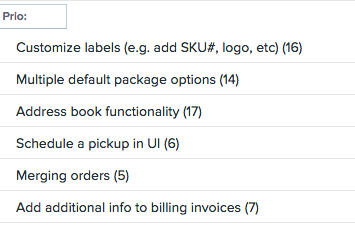Focus on what you do best: stick to your core value proposition.
By Laura Behrens Wu (Founder & CEO, Shippo)
This is part four of a series from one of our How To Conference speakers. Laura Behrens Wu spoke on our panel How to Create Value with the Right Business Model. Read part one, part two and part three.
At Shippo, our focus early on became to build a shipping rate engine and label-creation technology that outperform any other shipping API or app on the market. We aimed to offer the simplest label-generation process plus the best USPS and international discounts while providing kick-ass customer service for a comprehensively intuitive solution.
We also wanted to do a ton of other things – whiteboards full of things! – but the fact of the matter is that you just can’t do it all. Especially at an early stage when levels of uncertainty and risk are at their highest. Let me explain why being the best at everything just won’t work.
Nobody wants to turn customers away, but product empires are not built overnight. Resources can’t be allocated for every customer request.
This means that as you are first building your MVP or any other early iteration of your product, you’ll often have to tell some of your potential and actual customers that you can’t build that one feature they’re pleading for, or that your product is simply not a good fit for what they’re trying to achieve. That hurts!
But building around your core value proposition and not wavering from that goal means staying focused. Becoming the very best at something means dedication, conviction, and stick-to-itiveness like none other. We continue to focus on our core product – our API – and try to make that better every day.
Of course, improving Shippo’s offerings does mean adding features over time, once a solid foundation is built. Reaching product-market fit affords more flexibility in this.
Early on, we implemented a simple procedure for keeping track of every customer feature request. We took every idea to heart and dropped it in an organized and regularly updated Asana task list, complete with project details and information about the customers who asked for the feature.
Our whole team uses this tool religiously. We keep a running tally of how many customers ask for specific features and make note of what kinds of customers these are. Using these tallies, we refresh the priority level of each request every two weeks, and our co-founder and lead engineer Simon uses this list in conjunction with the engineering team’s backlog to determine which projects should be started next.
These are a few of the items on our Asana list. Transparency!
We have several criteria for identifying which features to prioritize. I mentioned in my last post that Shippo’s brand values are simplicity and friendliness. These values guide our decision-making: if a feature does not further those values, we won’t build it. The key here is that new projects are only established once it’s clear that they:
1. Strengthen our values
2. Support our core value-proposition
3. Benefit the majority of customers or majority of shipments
I think any engineer would tell you that our Asana prioritization is a pretty typical workflow, but the important lesson here is staying focused on your core product goals. As a reminder, we constantly ask ourselves, “What are we the best at?”
Our highest-priority projects have been ranked the way they are for a reason and it doesn’t make sense to become distracted by other tasks at the expense of those core priorities. Even if they are simple.
Many entrepreneurs praise the value of saying “No” in these situations. Very often saying “No” is important, but sometimes it’s better just to say, “Wait.” That list of requests is crucial data and gains in value the more feedback you receive.
Keeping track of all of these requests – but not acting on them as they come up – often allows you to address multiple birds with one stone. For example, many customers ask us for particular carrier and e-commerce store integrations that we haven’t yet built.
Instead of building each and every one of these integrations for users claiming to ship X thousand packages a month, we needed a more immediately scalable solution that would impact the widest swath of our target customers. So, we built a workaround that serves all of these customers in an alternative way – our CSV upload tool was born!
Whether you need to say, “No,” “Wait,” or “We’ll definitely consider that,” to a feature request, it’s important to be honest about your capabilities and resources with your customers. If Shippo is missing a critical feature for a customer and it’s not on our immediate roadmap, we’ll refer them to another company that we know has the exact features they need.
Why? Because being genuinely helpful doesn’t mean you have to build everything your customers ask for and risk ruin in the process. Sometimes being helpful just means being honest and genuine.
As I mentioned when I wrote about our experience with live chat, being authentic and focused helps us build stronger relationships with our customers than scrambling to implement features ever could.
Focus on what you do best. Get that right. And then add other pieces to the core of the puzzle.
Photo credit: foodiepics via Shutterstock.

